Fermenting Beer with White Labs WLP500 Monastery Ale Yeast
Published: September 30, 2025 at 11:04:50 PM UTC
Last updated: October 1, 2025 at 7:18:34 AM UTC
This Monastery Ale Yeast review is a practical guide for homebrewers and small craft operations in the United States. It aims to explain how White Labs WLP500 Monastery Ale Yeast performs in real brews. It offers clear, usable guidance for brewing Belgian quads, tripels, dubbels, Belgian dark strong ales, Belgian pale ales, biere de garde, and even cider.
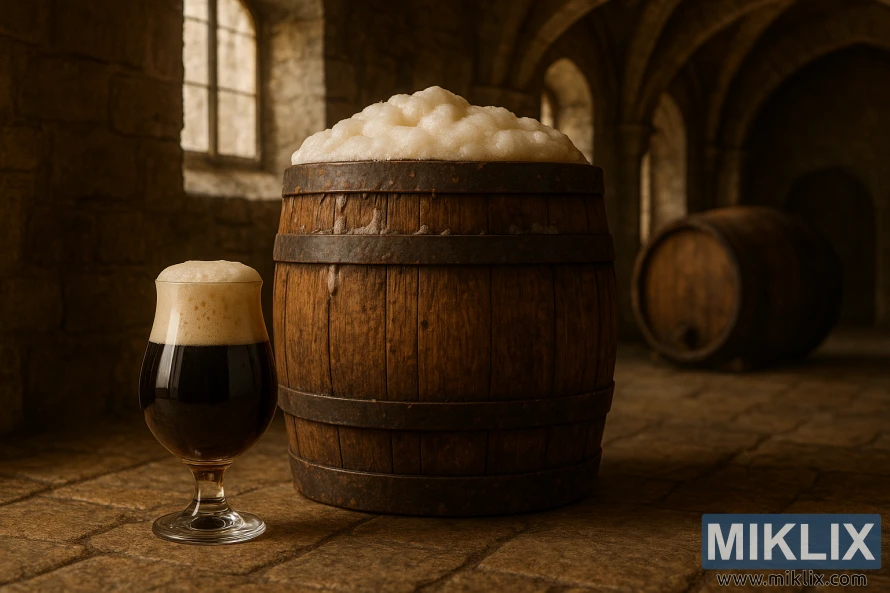
WLP500 comes from a Belgian monastery strain, known for its bold fruit character and strong attenuation. White Labs reports attenuation around 75–80%, flocculation as low-to-medium, and alcohol tolerance in the 10–15% range. The recommended fermentation window is 65–72°F (18–22°C), and STA1 QC testing is negative.
The flavor snapshot leans toward plum and cherry with a subtle bubble gum note. Fermenting with WLP500 at the lower end (65–67°F / 18–19°C) tames the esters and shifts the profile toward earthier phenolics. Brewers will find the yeast available as the White Labs core liquid vial, with some retailers also providing organic and PurePitch/Next Generation formats at varying price points.
Key Takeaways
- White Labs WLP500 Monastery Ale Yeast is suited for Belgian strongs and biere de garde.
- Expect 75–80% attenuation and low-to-medium flocculation.
- Fermentation at 65–72°F (18–22°C) balances fruit and phenolic notes.
- Flavor: plum, cherry, and a light bubble gum character; cooler temps yield earthier tones.
- Available as WLP500 liquid vial; PurePitch and organic options appear at some retailers.
Overview of White Labs WLP500 Monastery Ale Yeast
WLP500 Monastery Ale Yeast by White Labs is a core strain of Saccharomyces cerevisiae, renowned for its classic Belgian profiles. It is celebrated for its ability to produce rich esters and complex phenolics. These characteristics are ideal for Belgian Dark Strong Ale, Tripel, Dubbel, and Belgian Pale Ale.
The Monastery Ale Yeast's origin is rooted in Trappist brewing traditions in Belgium. It is favored by brewers seeking authentic notes reminiscent of abbey and monastery beers. White Labs offers lab-verified data, including a STA1 QC result listed as negative. This is significant for diastaticus screening.
Beyond Belgian styles, WLP500 is versatile. Brewers have successfully used it for high-gravity ales, Biere de Garde, and even some ciders. They seek its warm, fruity character. White Labs provides both standard and Organic variants for those requiring certified organic ingredients.
- Strain identity: Saccharomyces cerevisiae, core strain.
- Monastery Ale Yeast origin: derived from Belgian monastery/Trappist tradition.
- WLP500 description: produces fruity esters, subtle phenolics, and strong attenuation for bold ales.
- Lab verification: STA1 QC negative for diastaticus activity.
- Availability: standard and organic options from White Labs.
Key Brewing Characteristics and Lab Data
White Labs lab data reveals WLP500 attenuation at 75%–80%. This means brewers can anticipate a drier finish in beers that are well-suited for this strain. It's a testament to the yeast's ability to convert sugars effectively.
WLP500 flocculation is reported as low to medium, with some notes suggesting a medium-low rating. This characteristic means the yeast tends to stay suspended longer. Brewers might need to extend conditioning or wait longer for clarity to emerge.
White Labs data indicates WLP500 alcohol tolerance spans 10%–15% ABV. This high tolerance is beneficial for brewing strong Belgian styles and high-gravity ales. It ensures the yeast can handle the alcohol without stress.
Recommended fermentation temperatures range from 65° to 72°F (18°–22°C). Fermenting at the lower end can help minimize fruity esters. On the other hand, fermenting at the upper end can accelerate attenuation and enhance estery flavors.
- STA1 QC result: negative, so no diastaticus activity was detected in White Labs testing.
- Practical implication: use WLP500 attenuation figures for accurate ABV planning and expect more time for settling due to WLP500 flocculation levels.
- Practical implication: count on WLP500 alcohol tolerance when targeting stronger final gravities.
When planning a brew, it's essential to balance mash and fermentation temperatures. This ensures the strain's attenuation profile is met. Also, allow for extended conditioning to manage clarity, given the yeast's flocculation tendencies.
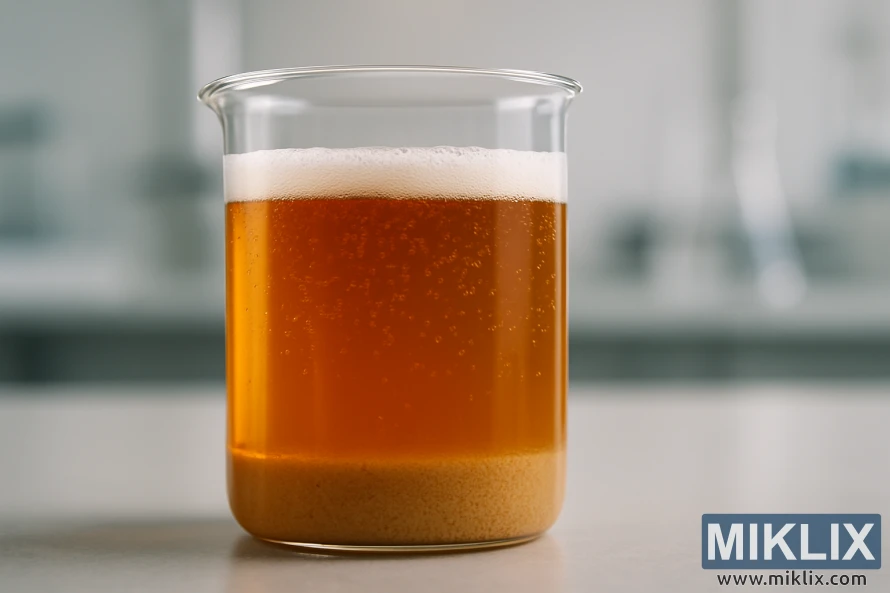
Optimal Fermentation Temperatures and Effects on Flavor
WLP500 fermentation temperature is best between 65–72°F (18–22°C). Starting near 65°F helps the yeast settle in smoothly, avoiding a sudden ester spike. For a subtle, earthy flavor, start at the lower end of this range.
As temperatures rise to 70–72°F, fruit-forward esters become more pronounced. Expect notes of plum, cherry, and a hint of bubble-gum. This approach is ideal for achieving the fruity lift characteristic of Trappist-style ales.
WLP500 flavor control hinges on maintaining a steady temperature and timing. Begin with cooler temperatures for restrained esters, then gradually increase if you desire more estery complexity. Pay attention to krausen peaks and collapse, as these often coincide with temperature changes that impact flavor.
Belgian yeast temperature effects are significant, even more so in high-gravity batches. Excessive heat can lead to solvent-like fusels or sharp phenolics. It's essential to stay within the recommended temperature range and avoid sudden temperature changes to prevent off-flavors.
- Use a temperature-controlled fermentation chamber for consistent results.
- Swamp coolers paired with a digital controller offer budget-friendly control.
- Glycol jackets work best for long, warm fermentations in commercial setups.
To achieve consistent beers, log temperatures and sensory notes for each batch. Monitoring how WLP500 fermentation temperature influences esters and mouthfeel will refine WLP500 flavor control over time.
Pitching Rates, Starters, and PurePitch Options
Choose your pack based on batch gravity and time. White Labs PurePitch Next Generation pouches offer higher cell counts than standard liquid vials. This can eliminate the need for a WLP500 starter for many 5-gallon ales.
For standard vials, a WLP500 starter is necessary for high alcohol or high gravity brews. It ensures a healthy fermentation and consistent attenuation. Starters should be made 24–48 hours before pitching.
- Match manufacturer cell counts to your batch gravity before deciding.
- When in doubt, build a small starter to avoid underpitching risks.
PurePitch WLP500 and similar high-cell-count offerings follow commercial guidelines around 7.5 million cells/mL. Check the pouch label and your recipe gravity to confirm if the cell count meets your target WLP500 pitching rate.
Oxygenation at pitching is critical. Even with PurePitch WLP500 or pouches, ensure adequate dissolved oxygen for yeast growth. Pitch at the lower end of the recommended temperature range to curb ester production.
Practical steps for brewers:
- Verify the cell count on the White Labs PurePitch Next Generation pouch or vial.
- Compare that count to your batch gravity and decide if a WLP500 starter is needed.
- If brewing high-OG beers, prepare a starter to reach the desired WLP500 pitching rate.
When using PurePitch or pouches, confirm manufacturer numbers. If uncertain, make a small-scale starter. This approach protects fermentation performance and preserves the characteristic profile of WLP500 Monastery Ale yeast.
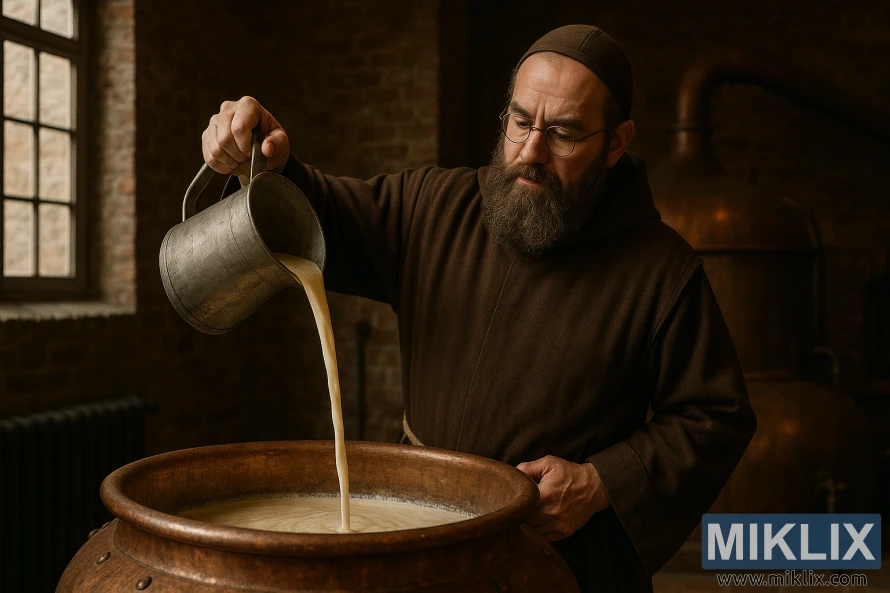
Fermentation Timeline and Monitoring for Belgian Ales
Active fermentation with WLP500 starts between 12 and 72 hours post-pitching. The timeline varies based on pitch rate, fermentation temperature, and wort oxygenation.
Primary fermentation for moderate-strength Belgian ales usually concludes in days to two weeks. A Belgian ale fermentation schedule should account for gravity. Tripels and quads, being stronger, require additional days or weeks to reach terminal gravity.
Begin monitoring early. Daily specific gravity checks are essential in the first few days. Post-krausen collapse, measure every 48 hours until readings stabilize.
- Track expected attenuation near 75–80% as a guide.
- Record temperature with a log to link ester changes to thermal swings.
- Use a hydrometer or refractometer; apply alcohol correction when using a refractometer.
For high-gravity beers, allow extended time for attenuation. Yeast can stall under high osmotic pressure. Gentle temperature increases of 2–3°F late in fermentation may aid in finishing without stressing the yeast.
WLP500 shows low-to-medium flocculation, necessitating longer conditioning. Conditioning times range from weeks for pale dubbels to months for quads and other strong ales.
To monitor fermentation WLP500, maintain detailed logs of gravity, temperature, and visible activity. Consistent data aids in determining the right time for racking, bottling, or kegging. This preserves the delicate ester profile Belgian ales require.
Flavor Development: Fruity Esters and Bubble Gum Notes
The WLP500 flavor profile is centered around lively Belgian yeast esters. These esters are often described as plum and cherry notes with a hint of bubble gum. They emerge early in fermentation, when yeast converts higher alcohols into fruity esters.
Fermentation temperature plays a significant role in shaping the flavor. Fermenting at 70–72°F enhances plum and cherry notes and brings out the bubble gum ester. On the other hand, fermenting at 65–67°F reduces fruitiness, favoring earthier phenolics.
The choice of recipe also influences the expression of Belgian yeast esters. A richer malt bill and higher original gravity can push ester production towards banana, plum, and cherry. Limiting oxygen at pitch and cautious aeration timing can help control ester formation.
Pitching rate and yeast health are critical. A robust, healthy starter promotes clean attenuation and a balanced ester profile. Underpitching can boost fruity esters, while a strong pitch tends to restrain them.
- To emphasize esters: ferment mid-to-high range of the profile and ensure vigorous yeast health.
- To reduce esters: lower fermentation temperature and avoid late wort aeration that creates ester precursors.
Conditioning softens the sharp edges of esters. Extended tank or bottle conditioning allows plum and cherry notes to integrate and the bubble gum ester to mellow. Many Belgian ales gain complexity as Belgian yeast esters evolve during weeks or months of maturation.
Managing Attenuation and Final Alcohol Content
WLP500 attenuation usually ranges from 75% to 80%, as stated by White Labs and retail data. This range is a good starting point for calculating ABV WLP500 and planning your recipe. For session and standard Belgian ales, this range provides a reliable estimate of final gravity WLP500.
To calculate ABV WLP500, begin with your original gravity and apply the expected attenuation. For instance, a 1.060 OG at 75% attenuation will yield a different ABV than the same OG at 80%. It's wise to work with a range to account for yeast variability under real brewing conditions.
Effective yeast management is key to managing attenuation. Ensure proper cell counts and oxygenate the wort at the start to aid yeast in reaching the target attenuation. If your mash is highly fermentable or you add simple sugars, expect a lower final gravity WLP500 and slightly higher alcohol content.
High-gravity brewing demands extra attention. Implementing staggered oxygenation, adding yeast nutrients, and gradually increasing temperatures can help yeast reach the expected attenuation without over-stressing them. WLP500 can handle high alcohol levels well, finishing beers up to 10%–15% ABV with the right support.
Keep in mind the lab constraints when planning attenuation. WLP500 tests STA1 negative, meaning it lacks diastaticus activity. This implies that attenuation reflects standard sugar conversion, not extended dextrin breakdown. Use this knowledge when setting targets for final gravity WLP500 and when calculating ABV WLP500 for recipe scaling.
Regular checks during fermentation are essential for managing attenuation. Measure gravity at peak activity and near apparent completion. If readings stall above your expected final gravity WLP500, consider early oxygenation or a controlled temperature rise to reactivate the yeast.
- Plan with 75%–80% WLP500 attenuation in mind.
- Calculate ABV WLP500 using OG and expected FG ranges.
- Support yeast health to hit final gravity WLP500 targets.
- Use staggered oxygen and nutrients for high-gravity batches.
Flocculation, Conditioning, and Clarity Strategies
WLP500 flocculation falls into the low-to-medium range. Yeast tends to stay suspended longer, leading to slower visual clearing. Brewers should plan for extended conditioning and be patient with appearance changes.
For conditioning Belgian ales, give strong or high-gravity beers extra time in secondary or cold storage. Weeks to months of aging allow esters to settle and proteins and yeast to compact. This enhances flavor balance and clarity.
Cold conditioning promotes a more pronounced cold break. Lowering temperatures after primary fermentation for several days to weeks encourages clearing WLP500. Lower temperatures help coagulate haze-forming compounds.
Use fining agents for a faster result. Irish moss in the boil aids in kettle clarity. Gelatin or isinglass in conditioning tanks can speed up clearing WLP500 without stripping character.
Polyclar (PVPP) is a good option for removing polyphenol haze. It suits both small breweries and advanced homebrewers aiming to remove chill haze while preserving aroma.
Filtration is a practical choice for small commercial operations. Homebrewers often rely on time, cold conditioning, and finings to achieve acceptable clarity without heavy equipment.
Mind yeast flocculation strategies at packaging. Rack or siphon from settled beer and leave trub behind. Bottling or kegging too early can trap yeast, leading to cloudiness or yeasty flavor.
- Extended secondary aging for conditioning Belgian ales
- Cold conditioning to improve clearing WLP500
- Use of kettle finings and post-fermentation finings
- Filtration when speed and polish are required
Track gravity and visual cues, not fixed days. This approach prevents premature packaging and supports better clarity outcomes when working with the WLP500 flocculation profile.
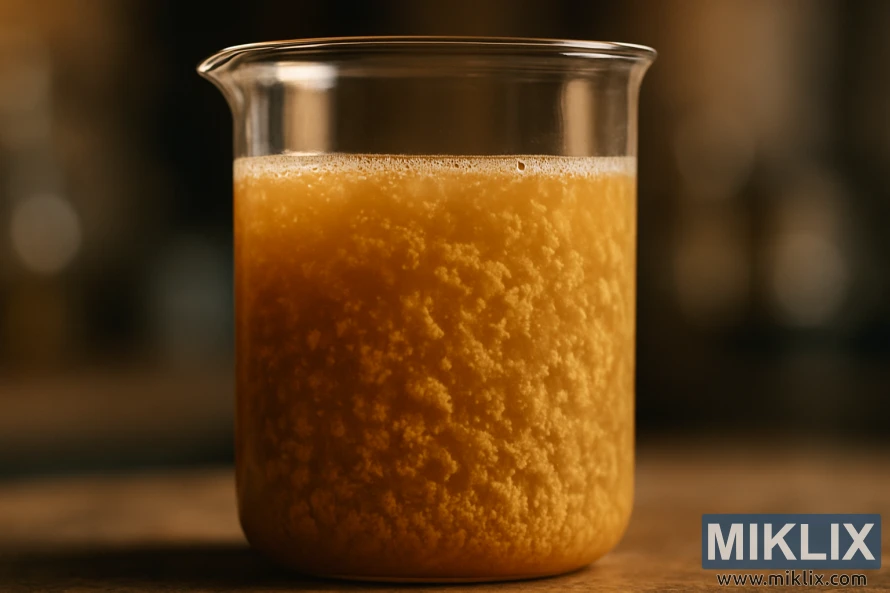
High-Gravity Brewing with WLP500 Monastery Ale Yeast
WLP500 stands out in brewing high-gravity Belgian styles, tolerating alcohol levels up to 15%. For those aiming at a WLP500 tripel quad, it's essential to plan for a strong wort gravity. This requires robust yeast handling.
To begin, a large starter or PurePitch high-cell-count pouches are recommended. They provide the necessary biomass. Proper pitching is key to avoid long lag phases and stalled fermentation in high-gravity brewing.
Adding yeast nutrients at pitching and thorough oxygenation are critical. For worts with very high OG, consider staggered oxygenation or oxygenation boosters. This ensures the yeast has the resources for healthy cell growth.
Controlling fermentation temperature is vital. It helps manage ester levels while keeping the yeast active. Expect longer fermentation and conditioning times for WLP500 tripel quad recipes. Patience is key to preserve the complex esters typical of this strain.
- Preparation: robust starter or PurePitch pouches.
- Nutrients: yeast nutrient at pitching and during early fermentation.
- Oxygenation: thorough initial oxygenation; staggered doses for very high OG.
- Temperature: steady control to balance esters and attenuation.
With proper management, WLP500 will reach an attenuation of 75–80%. It will produce the aromatic profile expected in strong Belgian ales. These steps ensure a clean, powerful finish. They do so without compromising mouthfeel or flavor complexity.
Pairing WLP500 with Yeast Substitutes and Comparables
When WLP500 is out of stock or you seek a different ester profile, several alternatives are available. Retailers and yeast banks often recommend WY1214, B63, and GY014 as suitable substitutes. Each strain offers a unique balance of fruit and phenol notes, allowing you to tailor your recipe's flavor profile.
Comparing WLP500 with other yeasts can help you understand differences in attenuation, flocculation, and ester production. For instance, WY1214 may produce more pronounced fruity esters in some batches. On the other hand, B63 or GY014 might offer clearer differences in attenuation. Always compare lab data and tasting notes before making a switch to avoid unexpected changes in body and finish.
When considering WY1214 as an alternative, keep in mind the importance of matching ester profiles. Adjusting fermentation temperature by a few degrees and tweaking pitching rates can help steer the flavor towards WLP500's plum, cherry, and bubble gum notes. Small adjustments in cell count and temperature can significantly impact ester production.
For brewers aiming for spice and subtle phenols, a T-58 comparison is beneficial. T-58 imparts a bready, spicy character with restrained esters. If substituting T-58, consider lowering the temperature or shortening the main fermentation to preserve some fruit character while avoiding phenol dominance.
- Check attenuation ranges for each option to predict final gravity.
- Match flocculation behavior to your clarity goals and conditioning timeline.
- Source from White Labs distributors, Wyeast, or reputable homebrew shops for consistent lots and PurePitch formats.
When experimenting, keep detailed records of pitch rate, temperature, and tasting milestones. Conducting controlled trials with a single variable will help you understand how each substitute affects the beer. This approach ensures consistent results through repeatable yeast comparisons.
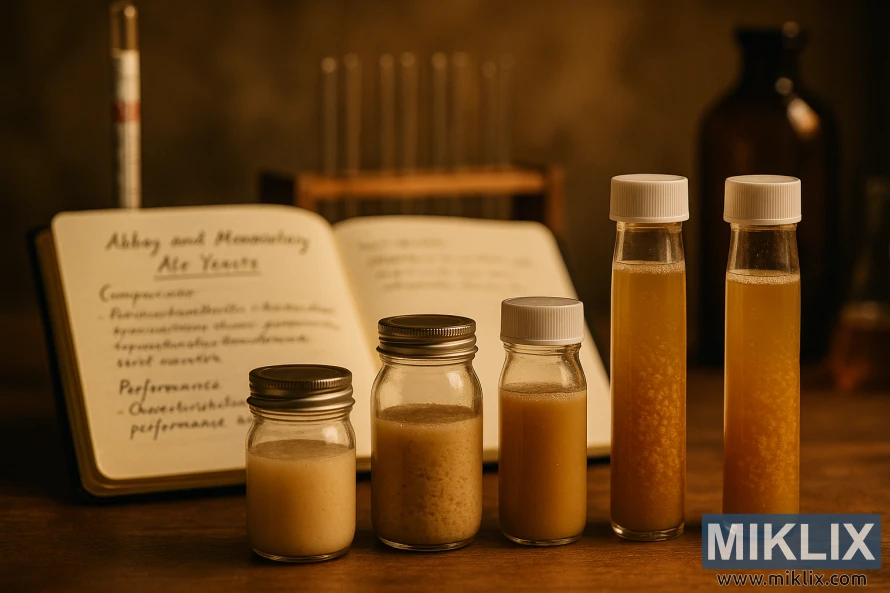
Packaging, Carbonation, and Bottling Considerations
Plan WLP500 bottling after fermentation has fully reached a stable final gravity. WLP500 packaging works best when you confirm attenuation over a few days to avoid unexpected refermentation in bottles. Stable readings reduce the risk of over-carbonation and off-flavors.
For carbonating Belgian ales, target higher CO2 volumes than for many other styles. Aim for 2.4–3.0 volumes depending on whether you are making a dubbel, tripel, or quad. Use accurate priming sugar calculations and weigh your additions to keep carbonation consistent across a batch.
Bottle conditioning WLP500 requires attention to yeast availability and settling. Because this strain can flocculate well, allow time in bulk conditioning so plenty of active yeast remains for priming. Transferring overly clear beer to bottles can lead to slow or uneven bottle conditioning WLP500.
Follow these practical steps before packaging:
- Confirm final gravity is stable for at least three days.
- Cold condition in a bright or conditioning tank to improve clarity.
- Calculate priming sugar precisely for the desired volumes of CO2.
- Stir gently when adding priming sugar to avoid aeration.
For commercial WLP500 packaging, allow extra tank time to mature flavor and drop yeast. Kegging or force carbonation can be useful when you need tight control over volumes of CO2. When using force carbonation, rack off trub and condition long enough to let flavors meld before distribution.
Keep package stability in mind. WLP500’s alcohol tolerance lowers the chance of stalled refermentation, but residual sugars can shift after bottling. Label beers with cellaring guidance where appropriate and store finished bottles at a steady temperature for reliable bottle conditioning WLP500 outcomes.
Troubleshooting Common Fermentation Issues with WLP500
Stalled or slow fermentations are common with Monastery Ale yeast. First, check your pitching rate. Low viable yeast or poor oxygen at pitch often causes stalls. A healthy starter, proper oxygenation, and yeast nutrients can get most batches moving again.
If gravity is high, consider a controlled temperature rise to nudge activity. This approach can fix stuck fermentation WLP500 when yeast need a little heat to finish. Use measured hops of heat, watch activity, and avoid sudden swings that stress the culture.
- Insufficient pitch: build a starter or use a PurePitch vial to boost cell count.
- Low oxygen: aerate wort before pitching to support early growth.
- Nutrient gaps: add yeast nutrient per manufacturer guidelines.
Excessive esters, such as bubble-gum notes, often trace to warm fermentations or yeast stress. Lowering fermentation temperature and ensuring correct pitch and oxygen reduces ester production. Allow extended conditioning; Monastery Ale yeast problems will often calm with time in bright tanks or bottles.
Poor clarity is common because WLP500 shows low-to-medium flocculation. Cold crash, fine with isinglass or Irish moss, or add time for lager-like settling. Commercial brewers may filter, while homebrewers gain clarity through extended conditioning and gentle cold storage.
Fusel alcohols and other off-flavors link to temperatures above the recommended 65–72°F range or to stressed cells. Keep fermentation in that window and monitor readings daily. Proper sanitation and steady gravity drops lower the risk of solvent-like characters.
- Check mash fermentability if attenuation is low.
- Verify yeast viability and increase pitch if needed.
- Use yeast nutrients and consider a stepped temperature rise to encourage finish.
When you apply these checks, WLP500 troubleshooting becomes a methodical process instead of a guess. Taking small corrective steps preserves flavor and helps prevent repeat Monastery Ale yeast problems on future brews.
Conclusion
White Labs WLP500 Monastery Ale yeast is highly regarded for its versatility in brewing Belgian strong ales. It consistently reaches 75–80% attenuation, performing best at temperatures between 65–72°F. Its low-to-medium flocculation and high alcohol tolerance make it ideal for complex, high-gravity recipes.
The yeast's flavor profile is notable, with plum, cherry, and a hint of bubble-gum. This is influenced by fermentation temperature and pitching rates. For fruit-forward esters, ferment warmer and use moderate pitch rates. For cleaner or earthier notes, tighten temperature control and employ robust starters.
Practical brewing tips with WLP500 include using PurePitch high-cell-count pouches or healthy starters for high-gravity batches. Monitor fermentation progress with a hydrometer or refractometer. Allow for extended conditioning to enhance clarity and flavor integration. White Labs offers WLP500 directly and through homebrew shops, including an organic option for those requiring organic ingredients.
Further Reading
If you enjoyed this post, you may also like these suggestions:
- Fermenting Beer with Fermentis SafSour LP 652 Bacteria
- Fermenting Beer with White Labs WLP351 Bavarian Weizen Ale Yeast
- Fermenting Beer with CellarScience English Yeast
